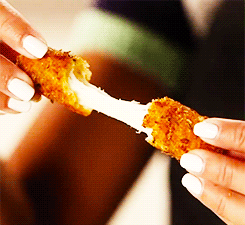When we all returned to school a few weeks ago, a few things were different from last year: the north side of the DUC is decked out with trees and rocking chairs, all salads on campus are charged by weight instead of size and….the beloved mozzarella sticks are gone.
To say there has been a pro-return-of-the-mozz-sticks uprising would be an understatement. Considering that this delectable calorie-packed snack is only offered in Bear’s Den, a dining hall primarily for underclassmen, you might think the argument would be headed by South 40 residents. But no.
There has been a school-wide petition against the removal of this common late-night snack, so fondly associated with the drunken post-game of an open frat party or maybe the barefooted (holding your heels in your hand) return from an off-campus formal function.
The immediate blame for the missing mozz sticks was directed at Connie Diekman, the school nutritionist known for Connie’s Choice, a selection of healthier meals and food items at each station, labeled with Connie’s stamp of approval.
Last week, I interviewed Connie to get the real story of what exactly happened to the mozz sticks.
The short answer? It’s the end result of a bureaucratic shift that traces its roots all the way up to the White House. (Say what?!) More specifically, Washington University was one of the first 20 schools to sign a 3-year agreement with the Partnership for a Healthier America, a national campaign offshoot of First Lady Michelle Obama’s Let’s Move Campaign.
Diekman says, “This is a commitment that we made because the university’s goals are that we graduate bright, healthy young adults. So, the commitment was to provide an environment that promotes health. With that said, there are a plethora of choices still available that don’t necessarily fit into that.”
Here’s the skinny:
- Wash U chose 23 goals out of the suggested 35, which fall under categories of food and nutrition, physical activity and programming
- Last year, the school had to decide how to implement those goals
- One of them restricts the number of fried foods the school can offer to equal or fewer than the number of food stations (think: pasta station, world fusion, etc.)
To my surprise, Connie then told me that based on sales data, onion rings and mozzarella sticks were the two fried food items least preferred by students. The onion rings? No surprise—in fact, it doesn’t seem like many students have noticed their absence. But, the mozzarella sticks are another story.

Gif courtesy of @fatfatties
Although I’m not an avid mozz sticks fan, I was initially quick to join the students advocating free choice, who argue that we are mature enough to make healthy (and unhealthy) eating choices on our own accord.
But after speaking with Connie, I’m more sympathetic to the alternative—it’s nearly impossible for dining services to honor the request for mozz sticks just on the basis of students’ desire, when the school has just signed on to a plan to help us all lead more successful lives in the future.
And, after all, we did buy into the school’s values when we decided to come here in the first place…
If you’re reading this and wondering about the recent return of the mozzarella sticks these past couple of Fridays, I have word from Connie that the sticks will continue to be offered on occasional days (although not necessarily Fridays, as they recently have been).
Contrary to popular belief (and the tone of a recent Student Life article), Diekman wants to make clear that the petition did not have any role in the decision to bring back the sticks – Dining Services had planned to offer them occasionally from the get-go.
Students should expect a few other food-related changes, which are also part of the school’s compliance with the Partnership for a Healthier America: a wellness meal (AKA MyPlate meal) will be provided at breakfast, five types of fruits and vegetables (AKA not just apples), as well as two whole grains will be offered at lunch and dinner, three desserts with fewer than 150 calories will be offered at lunch and dinner, and there will be a plant-based option at every station. While these may not be implemented right away, students can expect them over the next couple of years.


